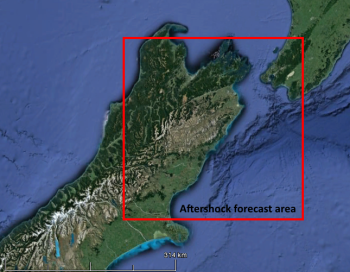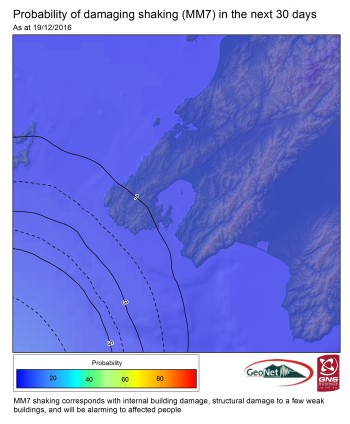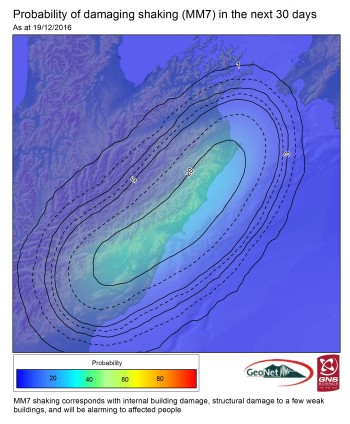
M7.8 Kaikoura Quake: Future Scenarios and Aftershock Forecasts
This story will no longer be updated
More earthquakes will occur as part of the Kaikoura earthquake sequence, and we expect aftershocks to continue for months to years. We understand that aftershocks can be upsetting for some people. These feelings are completely normal. The best advice we have is to be prepared for earthquakes. Seek support with friends and family, and if you need additional support please see the information at the bottom of this page.
Remember: Drop, cover and hold in an earthquake. If the earthquake is long or strong and you are near the coast, evacuate as soon as the shaking stops. Do not wait for an official warning or sirens.
Future aftershocks
To help understand the earthquakes and what to do about them, many people want to know what will happen next. While we can’t predict earthquakes we can provide forecasts of future aftershocks (based on probabilities), and possible scenarios.
Most earthquake aftershock sequences decay (i.e. the number of earthquakes generally decreases) over time, with spikes of activity and occasional larger earthquakes. The latest update to this story provides a further update, and an outline of our move from 30 day to yearly forecasts for the scenarios.
Most aftershocks of the magnitude 7.8 Kaikoura earthquake are occurring throughout a broad area from North Canterbury through to Cook Strait that surrounds the faults that ruptured in that earthquake, although a few have occurred in the lower North Island. We forecast aftershock probabilities for the area in the red box on the map to the right. The area near the centre of the box (around Kaikoura) is more likely to experience felt aftershocks than areas towards the edge of the box. See the MMI map lower down for more information on the forecast shaking for the Wellington area. Earthquakes can and do happen outside this box but the box represents the most likely area for aftershocks in this sequence.
| Average number of M5.0-5.9 | Range* of M5.0-5.9 | Probability of 1 or more M5.0-5.9 | Average number of M6.0-6.9 | Range* of M6.0-6.9 | Probability of 1 or more M6.0-6.9 | Average number of M≥7 | Range* of M≥7 | Probability of 1 or more M≥7 | |
| within 30 days | 8.4 | 2-18 | >99% | 0.8 | 0-3 | 54% | 0.08 | 0-1 | 8% |
| within 365 days | 33.3 | 19-51 | >99% | 3.1 | 0-7 | 95% | 0.3 | 0-2 | 25% |
Forecast for rectangular box with the coordinates -40.7, 171.7; -43.5, 171.7; -43.5, 175.5; -40.7, 175.5 at 12 noon, Monday, Monday, 19 December. * 95% confidence bounds.
For example, there is a 54% chance of one or more M6.0-6.9 earthquakes occurring within the next month. We estimate there will be between 0 and 3 earthquakes in this magnitude range within the next month. The current rate of magnitude 6 and above for the next month is about 30 times larger than what we would normally expect for long term seismicity represented in our National Seismic Hazard model. As the aftershock rates decrease, this difference will decrease as well.
The next update will be mid-January 2017 and can be found here. Given the rate of aftershocks, we will only update this information monthly, unless another large aftershock re-invigorates the earthquake sequence. Due to us moving to monthly forecasts, we are also removing the "within 7 days" probabilities from the above table.
Scenarios
The scenarios specifically address the probabilities of what we might see happen within the next year. The scenarios cover a wider geographic area than the aftershock probability forecast area. The probability numbers in the table above are slightly different to the scenarios. This is because we have used new information we have gathered from the slow-slip events, and their potential impact on the plate interface and other faults, to help define our probabilities in scenario three.
There are very different probabilities for each scenario; some of these may be more unsettling to you than others. We recognise that while these scenarios may increase anxiety the best thing is to be prepared. Remember: To drop, cover and hold in an earthquake. If you feel a long or strong earthquake and you are on the coast, evacuate immediately.
Scenario One : Likely (approximately 70% within the next year)
The most likely scenario is that aftershocks will continue to decrease in frequency (and in line with forecasts) over the next year and no aftershocks of magnitude 7 or larger will occur. Felt aftershocks (e.g. over magnitude 5) will occur in the area from North Canterbury to Cape Palliser/Wellington. It’s very likely (98% within the next year) that there will be at least one aftershock of magnitude 6.0-6.9 in the next year, regardless of there being a larger (magnitude 7.0+) earthquake.
Scenario Two: Unlikely (approximately 25% within the next year)
An earthquake smaller than the mainshock and between magnitude 7.0 to magnitude 7.8 will occur. There are numerous mapped faults in the North Canterbury, Marlborough, Cook Strait and Southern North Island areas capable of such an earthquake. It may also occur on an unmapped fault. This earthquake may be onshore or offshore but close enough to cause severe shaking on land. This scenario includes the possibility of an earthquake in the Hikurangi Subduction Zone. Earthquakes originating from here or in the Cook Strait have the potential to generate localised tsunami. The Hawke’s Bay earthquake sequence in 1931 provides an analogy to scenario two, as a magnitude 7.3 aftershock occurred approximately 2 weeks after the initial magnitude 7.8 earthquake.
Scenario Three: Very unlikely (5% within the next year)
A much less likely scenario than the previous two scenarios is that recent earthquake activity will trigger an earthquake larger than the magnitude 7.8 mainshock. This includes the possibility for an earthquake of greater than magnitude 8.0, which could be on the plate interface (where the Pacific Plate meets the Australian Plate). Although it is still very unlikely, the chances of this occurring have increased since before the magnitude 7.8 earthquake, and have also been also been slightly increased by the slow-slip events.
Initially our scenarios covered what might happen over the next 30 days, but we are now shifting to covering what might happen over the next year. This is because the aftershocks are generally becoming smaller and less frequent (decaying) over time, and this lower aftershock rate increases the uncertainty of what might happen over shorter time periods.
You may see a change in probabilities for the scenarios compared to the previous forecasts, but this can mostly be explained by the increase in timeframe used. Over time since the initial magnitude 7.8 earthquake the revised aftershock probabilities have generally decreased.
While we will continue to update the aftershock probabilities regularly, we will not update the scenarios as often.
Aftershock shaking forecasts
We also calculate the probability of damaging earthquake shaking from aftershocks over the next 30 days (starting 19 December 2016). Damaging earthquake shaking is defined as MM7 on the Modified Mercalli Intensity (MMI) scale. The MMI scale is different to earthquake magnitude – it describes the intensity and impacts of the shaking, which depend on the magnitude of the earthquake, how far away the earthquake was and the type of ground you are on. At MM7 intensity shaking it is difficult to stand, furniture and appliances move, contents are damaged, there is minor building damage and liquefaction can occur in susceptible sediments.
The map shows the probability of MM7 shaking within the aftershock region, which includes Wellington. Over the next 30 days the probability of MM7 shaking (in the next 30 days) around the wider Kaikoura/northern East Coast of the South Island is around 30-40% (reflected by the green colour).
In comparison, the probability of MM7 shaking in the Wellington area is less than 2% (dark blue). While this probability is considerably lower in Wellington than in the areas around Kaikoura, it is possible for shaking similar to what occurred during the mainshock to happen again in Wellington. Be aware that Wellington is already a high seismic risk area and the Kaikoura earthquake has increased this risk, as illustrated in the forecasts.
Christchurch's aftershock probabilities are not greatly affected by the magnitude 7.8 Kaikoura earthquake. The most recent update of the Christchurch aftershock probabilities are here. We update the Christchurch aftershock probabilities annually, due to the relative stability of the aftershock decay.
Tsunami and landslide hazards
A tsunami was created by the magnitude 7.8 Kaikoura earthquake, and our scientists are still analysing the tsunami data and collecting information on its impacts. Remember, if an earthquake is too strong to stand up in, or lasts longer than a minute, move inland or to higher ground immediately. Do not wait for a siren or an official warning.
The earthquake also caused thousands of landslides in North Canterbury, Kaikoura and Marlborough. These landslides remain dangerous and can move at any time. Please be careful around landslides and cracks in slopes. Heavy rain can pick up and carry landslide material and cause debris flows and debris floods (flash floods). Landslides have also dammed several rivers. These dams could breach, particularly in heavy rain. Please be careful and avoid riverbeds downstream of dams.
Take care of yourselves and others – physically and mentally
Earthquakes can be scary. It is normal and okay to be a bit scared about things that are scary. But the best thing you can do is take action and be prepared.
You can follow our friends at the Ministry of Civil Defence & Emergency Management on Twitter and Facebook for the latest earthquake and tsunami preparedness information. You can also follow your regional Civil Defence Emergency Management Groups.
If you are anxious about the earthquakes and this is affecting your ability to go about your daily life the All Right? Hotline (0800-777-846) is a great resource where you can talk about any anxieties or concerns that you have regarding the earthquakes. Remember to also seek support with friends and family, and to take time out to do things you enjoy.





